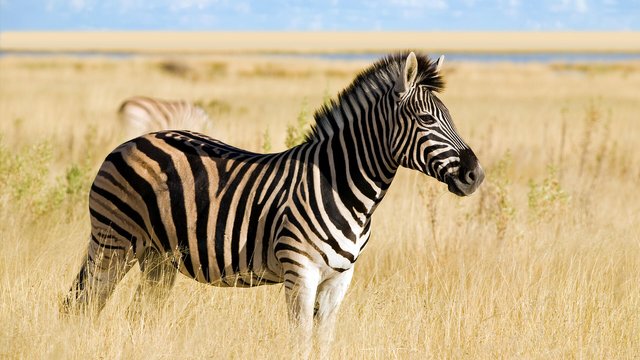
Despite their appearance, zebras aren’t just black and white. They are sturdy, spirited animals that are a study in contrasts: willful and playful, social and standoffish, resilient and vulnerable. Their life in a herd can be complex, yet they also find safety in numbers. They are prey for predators, but they are by no means shrinking violets when it comes to defending themselves. Read between the lines, and you’ll discover that the world of the zebra is colorful indeed!
Zebras are equids, members of the horse family. They have excellent hearing and eyesight and can run at speeds of up to 35 miles per hour (56 kilometers per hour). They also have a powerful kick that can cause serious injury to a predator, like a lion, a hyena, or an African wild dog. Usually the lead male of the herd, called a stallion, sounds the alarm if danger is spotted and stays at the back of the group to defend against predators if necessary, while the mares (females) and foals (youngsters) run away.
Zebras often trot when moving to new pastures, which is a fairly fast but easy gait for them to use over the long distances they may have to travel. Their hard hooves are designed to withstand the impact of their body weight and to run easily over rocky ground. When resting at night, zebras lie down while one stands watch to prevent an ambush.
Stripes: White with black or black with white? This is one of the most-asked questions about zebras. So what's up with the stripes? Zebras are generally thought to have white coats with black (sometimes brown) stripes. That's because if you look at most zebras, the stripes end on their belly and toward the inside of the legs, and the rest is all white. However (there had to be a catch, right?), some zebras are born with genetic variations that make them all black with white stripes, or mostly dark with the striped pattern on just part of their coats. And as it turns out, zebras have black skin underneath their hair. So it depends on how you look at it!
So, why the stripes? They serve as a kind of protection from predators! When zebras are grouped together, their combined stripes make it hard for a lion or leopard to pick out one zebra to chase. Zebra stripes are unique to each individual, and researchers in the field have used zebras’ individual stripe patterns for identification.
It might seem like a zebra is a zebra, but there are three different species: plains, mountain, and Grevy’s zebras. Different zebra species have different types of stripes, from narrow to wide. In fact, the farther south on the African plains you travel, the farther apart the stripes on the zebras get! The basic form of zebras—a large head, sturdy neck, long legs, a dorsal stripe along the spine and down a tasseled tail, and bristly mane—is universal. No zebra, or other wild equid, has a forelock.
The Grevy’s zebra is the largest, weighing from 770 to 990 pounds (350 to 450 kilograms) and measuring up to 5 feet (1.5 meters) at the shoulder. Its thick neck and large, round ears give the Grevy’s zebra the most mule-like physique. The Grevy’s zebra also has the thinnest stripes, extending all the way down to their white belly; on the hindquarters the stripes are vertical until above the hind legs.
A mountain zebra has vertical stripes on the neck and torso, which graduate to wider—and fewer—horizontal bars on the haunches. It has a gridiron pattern on the rump, and its white underside has a dark stripe that runs the length of the belly. A mountain zebra also has a distinctive dewlap on the throat that looks a bit like an Adam’s apple.
The plains zebra is the most abundant and the smallest of the three zebra species. Some subspecies have a stripe pattern different from all others: brownish “shadow” stripes between the black stripes on their coat.
HABITAT AND DIET
Different zebras have different habitats: Grevy’s zebras live in semi-arid grassland habitat in Kenya, Ethiopia, and Somalia. Mountain zebras, as their name implies, inhabit rocky, arid slopes in Namibia and Angola. Plains zebras, which are the most abundant of the three zebra species, are found from the grasslands of East Africa to the scrubby woodlands of southern Africa. They are one of Africa’s most successful and adaptable large herbivores. A subspecies of the plains zebra, the Grant’s zebra, is famous for its spectacular migrations during the rainy season in the Serengeti, when as many as 10,000 of these animals can be seen journeying together in congregated herds.
Zebras are herbivores and feed mostly by grazing on grasses, although they also might browse a bit on the leaves and stems of bushes. They graze for many hours each day, using their strong front teeth to clip off the tips of the grass. Their back teeth then crush and grind the food. Spending so much time chewing wears the teeth down, so those teeth keep growing all their lives.